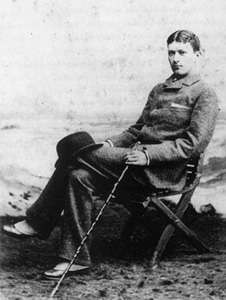Ogden Codman Jr.

Ogden Codman Jr. (January 19, 1863 – January 8, 1951) was an American architect and interior decorator in the Beaux-Arts styles, and co-author with Edith Wharton of The Decoration of Houses (1897), which became a standard in American interior design.
Early life
Codman was born to Ogden Codman Sr. (of Boston and the Codman House) and the former Sarah Bradlee in Boston, Massachusetts. He spent his youth from 1875 to 1884 at Dinard, an American resort colony in France, and on returning to America in 1884, studied at the Massachusetts Institute of Technology.
He was influenced in his career by two uncles, John Hubbard Sturgis (architect) and Richard Ogden (a decorator), and admired Italian and French architecture of the sixteenth, seventeenth, and eighteenth centuries, as well as English Georgian architecture and the colonial architecture of Boston.
After brief apprenticeships with Boston architectural firms, Codman started his own practice in Boston, where he kept offices from 1891 to 1893, after which time he relocated his main practice from Boston to New York City. Codman also opened offices in Newport, Rhode Island as early as 1891, and it was in Newport that he first met novelist Edith Wharton. She became one of his first Newport clients for her home there, Land's End. In her autobiography, A Backward Glance, Wharton wrote:
We asked him to alter and decorate the house—a somewhat new departure, since the architects of that day looked down on house-decoration as a branch of dress-making, and left the field up to the upholsterers, who crammed every room with curtains, lambrequins, jardinières of artificial plants, wobbly velvet-covered tables littered with silver gew-gaws, and festoons of lace on mantelpieces and dressing tables.
Codman viewed interior design as "a branch of architecture".
Architectural works
Wharton subsequently introduced Codman to Cornelius Vanderbilt II, who hired Codman in 1894 to design the second and third floor rooms of his Newport summer home, The Breakers, which he did in a clean eighteenth-century French and Italian classical style. Codman was not a draftsman, and it is said that in Paris he hired a talented group of students from the École des Beaux-Arts to draw up the sketches for Vanderbilt.
Codman was homosexual and pursued attractive young men throughout his life,[1][2] but in 1904 he married Leila Griswold Webb, the widow of railroad magnate H. Walter Webb who was six years old than him. She died in 1910, leaving him a fortune.
In 1907, Codman built what was later to be known at the Codman–Davis House in Washington, D.C. for his cousin Martha Codman. It is currently the official residence of the Ambassador of Thailand, and one of the few intact homes that he designed. This included a carriage house which now houses the Apex Night Club.
Codman's New York clients included John D. Rockefeller Jr., for whom he designed the interiors of the famous Rockefeller family mansion of Kykuit in 1913, and Frederick William Vanderbilt, for whom he designed the interiors for his mansion in Hyde Park, New York, and his house on Fifth Avenue. He also collaborated with Wharton on the redesign of her townhouse at 882–884 Park Avenue as well as on the design of The Mount, her house in Lenox, Massachusetts. His suave and idiomatic suite of Régence and Georgian parade rooms for entertaining are preserved in the townhouse at 991 Fifth Avenue, now occupied by the American Irish Historical Society. His French townhouse in the manner of Gabriel at 18 East 79th Street, for J. Woodward Haven (1908–09) is now occupied by Acquavella Galleries.[3]
All told, Codman designed 22 houses to completion, as well as the East Wing of the Metropolitan Club in New York. He also began the trend of lowering the townhouse entrance door from elevated stairways to the basement level. He designed a series of three houses in Louis XIV style at 7 (his own residence), 12, and 15 East 96th Street from 1912 to 1916. The New York City Landmarks Preservation Commission later described the facade of number 7 as being "full of gaiety and frivolous vitality" and further, "on approaching the house, Paris and the Champs-Élysées immediately come to mind."
In 1920, Codman left New York to return to France, where he spent the last thirty-one years of his life at the Château de Grégy, wintering at Villa Leopolda in Villefranche-sur-Mer, which he created by assembling a number of vernacular structures and their sites: it is his masterpiece, the fullest surviving expression of his esthetic. Codman died at age 87 in 1951. His architectural drawings and papers are collected at the Avery Architectural and Fine Arts Library at Columbia University; the Codman Family papers are also held by Historic New England and the Boston Athenaeum.
See also
References
Notes
- ↑ Doyle, Jnr, David D. (Oct 2004). ""A Very Proper Bostonian": Rediscovering Ogden Codman and His Late-Nineteenth-Century Queer World". Journal of the History of Sexuality. 13 (4): 446.
- ↑ Ferentinos, Susan. Interpreting LGBT History at Museums and Historic Sites. Rowman & Littlefield. pp. 135–7.
- ↑ Staff (September 20, 1977) Metropolitan Museum Historic District Designation Report New York City Landmarks Preservation Commission
Further reading
- Codman, Florence. The clever young Boston architect. Augusta, Maine: KJ Litho, 1970.
- Doumato, Lamia (ed.) (1989) Ogden Codman Jr. (1863–1951): A Bibliography, Monticello, Illinois: Vance Bibliographies.
- Metcalf, Pauline C. (ed.) (1988) Ogden Codman and the Decoration of Houses, Boston: Boston Athenaeum and D.R. Godine
External links
- Ogden Codman Architectural Drawings and Papers at the Avery Architectural and Fine Arts Library, Columbia University
- Ogden Codman Papers at the Boston Athenaeum
- Historic photographs of works by Codman at the Metropolitan Museum of Art.
- Works by Ogden Codman Jr. at Project Gutenberg
- Works by or about Ogden Codman Jr. at Internet Archive
- Works by Ogden Codman Jr. at LibriVox (public domain audiobooks)
